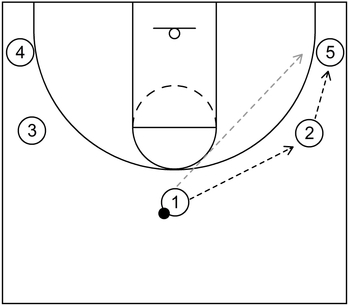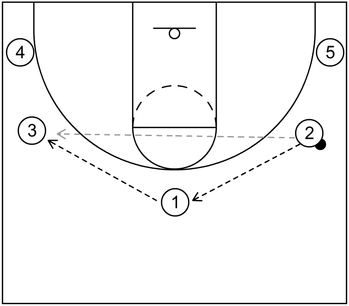What does one pass away mean in basketball
One pass away is a general concept that essentially means an offensive player in possession of the basketball only needs to pass it one time from its current area on the court such as the top to a new adjacent area on the court such as the wing.
What does the concept of one pass away mean in reference to basketball defense
When the ball is one pass away from the defender
In terms of basketball defense, when a defender is guarding an offensive player with the ball but that same offensive player passes it to an adjacent area such as from the top to the wing, this means that the defender is now one pass away from the ball.
Furthermore, the defender is also currently an off-ball help defender and therefore, that same defender should quickly jump to the ball.
When the defender jumps to the ball, this gives them the opportunity to take away a potential face cut by the offensive player that executed the pass and in addition to that, the defender could possibly limit dribble penetration by the offensive player that received the ball.
Additionally, in certain situations, if the ball is near a wing, then an off-ball help defender near the top, which is also one pass away, could drop back to protect the nail, which also limits dribble penetration, especially towards the middle near the lane.
Moreover, if an offensive player attempts to initiate dribble penetration, then it is also possible for an adjacent off-ball help defender one pass away to stunt at the ball as a method of slowing down that dribble penetration until the on-ball defender can recover.
Also, as another possible defensive action, an off-ball defender could deny the ball to an adjacent offensive player that is one pass away to prevent that same offensive player from easily receiving the ball.
When the ball is more than one pass away from the defender
Conversely, when the ball is more than one pass away, the help defenders, near the top, the wing opposite the ball (i.e. the weak side wing), and/or the corner opposite the ball (i.e the weak side corner) should slide laterally towards the center of the free throw line (i.e. the nail), the weak side high post, and/or the weak side low post area respectively.
Furthermore, in certain instances, when the ball gets passed to a side of the floor, an offensive player may not be currently occupying the low post area on that same side.
When that occurs, an off-ball help defender that is more than one pass away, preferably one that is lower on the court, such as a weak side corner defender, can slide into the lane to protect the basket.
Furthermore, if an off-ball help defender slides into the lane to protect the basket, then an additional help defender that is also more than one pass away on that same weak side of the court could drop back to stand in the gap between the weak side mid-post and the weak side corner.
What is a basic example of one pass away offensive action

This is a basic example of one pass away offensive action. On the diagram above, 1 is at the top and currently has possession of the basketball. At the same time, 2 is near the right side wing, and 3 is near the left side wing.
From there, let’s say that 2, near the right side wing, wanted to receive the ball from 1.
To accomplish this, 1 with the ball only has to execute one pass to move the ball from the top to the adjacent right side wing. In other words, 2, near the right side wing, is only one pass away from 1.
Likewise, let’s say that 3, near the left side wing wanted to receive the ball from 1. To achieve this, 1 with the ball only has to execute one pass to move the ball from the top to the adjacent left side wing.
In other words, 3, near the left side wing, is only one pass away from 1.
What are basic examples of more than one pass away offensive action
Example 1

This is an example in which the ball moves from one area on the court to another area that is more than one pass away. On the diagram above, 1 is at the top.
Also, 2 and 3 are on the wings and 4 and 5 are in the corners. This also happens to create a 5 out formation as well.
To start, 1 has current possession of the ball at the top but 5 is open to receive it. From that point, generally speaking, 1 would execute one pass so that 2 could receive the ball.
After that, 2 would execute one more pass so that 5 could receive the ball. In this case, the total number of passes executed was two. So, in other words, 5 was two passes away in the right side corner from the initial area at the top.
Alternatively, 5 could also receive the ball directly from 1 via a skip pass, represented by the gray dotted arrow. In that case, the ball would skip over the right side wing where 2 is currently located.
However, in the case of a skip pass, it should be noted that even though the ball is essentially passed only one time, the player that received it is still more than one pass away.
Put another way, although the ball may have skipped over a certain area (such as the right side wing), that area is still a part of the court and is therefore counted, from a place of origin to destination perspective.
Example 2

This is another example in which the ball moves from one area to another that is more than one pass away. For this demonstration, 2 is in current possession of the ball near the right side wing but 3 is open to receive it.
When that occurs, 2 could execute one pass so that 1 could receive the ball and following that, 1 could execute yet another pass so that 3 could receive the ball.
From there, the total number of passes would be two. Therefore, 3, at the destination, would be two passes away from 2, at the place of origin.
Furthermore, as a side note, those two passes from one side of the court to the other side is also known as ball reversal.
In addition to that, as an alternative option, 3 could also receive the ball directly from 2 via a skip pass, represented by the gray dotted arrow. In that case, the ball would skip over the top area where 1 is currently located.